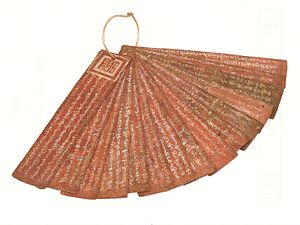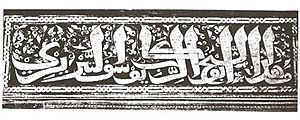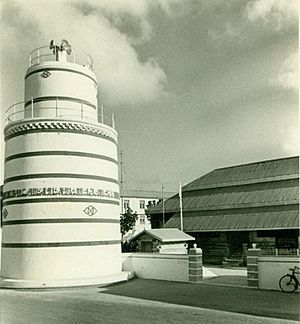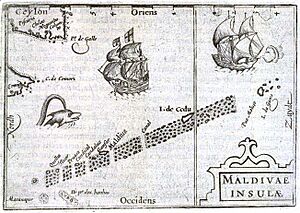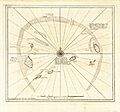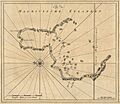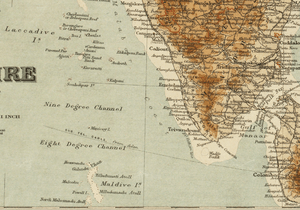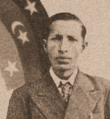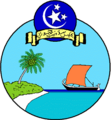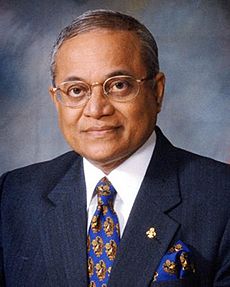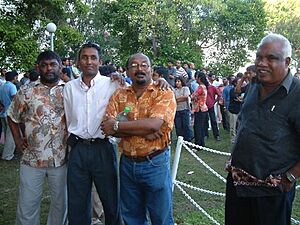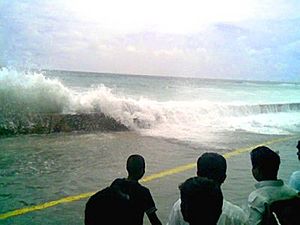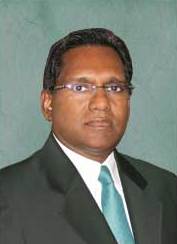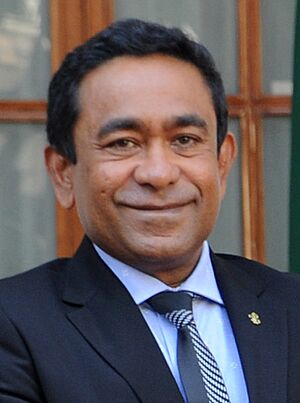History of the Maldives facts for kids
The history of the Maldives is deeply connected to the wider Indian subcontinent and the Indian Ocean region. The Maldives is a nation made up of 26 natural atolls and 1194 islands. For a long time, the Maldives has been important because of its location on major shipping routes in the Indian Ocean. Its closest neighbors are the British Indian Ocean Territory, Sri Lanka, and India.
The United Kingdom, Sri Lanka, and some Indian kingdoms have had cultural and economic ties with the Maldives for many centuries. Maldivians also traded with places like Aceh and other kingdoms in what is now Indonesia and Malaysia. The Maldives was the main source of cowrie shells, which were used as money across Asia and parts of East Africa. It's likely that the Maldives was influenced by the Kalingas from ancient India, who were early sea traders to Sri Lanka and the Maldives and helped spread Buddhism. Chinese crockery found in the Maldives also shows that there was trade between China and the islands. The Chinese admiral Zheng He visited the Maldives in 1411 and 1430. China was also the first country to open a diplomatic office in Malé in 1966.
After the 16th century, European powers like the Portuguese, Dutch, and French started to control trade in the Indian Ocean. They also interfered in Maldivian politics. However, this stopped when the Maldives became a British protectorate in the 19th century. This meant the Maldivian rulers had a good amount of self-governance.
The Maldives became fully independent from the British on July 26, 1965. But the British kept an air base on Gan island in the southernmost atoll until 1976. When the British left in 1976, during the Cold War, people wondered what would happen to the air base. The Soviet Union asked to use it, but the Maldives said no.
In the early 1990s, the biggest challenge for the Maldives was to grow its economy quickly and become more modern. This was hard because the country mainly relied on fishing and tourism. There was also worry about sea level rise, which would be very bad for the low-lying coral islands.
Contents
Early History of the Maldives
Much of the Maldives' early history is not fully known. However, old stories and some facts suggest that people have lived on the islands for over 2500 years. A scholar named Allama Ahmed Shihabuddine from Meedhoo wrote down an old story in the 17th century. This story matched known South Asian history, even mentioning Emperor Asoka from India. It also supported facts found in old Maldivian records and copperplate writings.
The northern islands might have been settled differently from the southern islands, which are about 800 kilometers away.
First Settlers in the South
A 4th-century note mentions that people called "Divi" sent gifts to the Roman Emperor Julian. "Divi" sounds a lot like "Dheyvi," which might be the same people. Later settlers included the Redi and Kunibee from India. The Aryas (Indo-Aryans) arrived around 6th-5th century BC. They brought Hinduism to the Maldives.
Dheeva Maari Kingdom
According to old stories, the Dheyvis first settled in Isdhuva. Then they found Suvadinmathi (Huvadhu Atoll). They named each island they found "duva." They then created the Dheeva Maari kingdom.
First Known King
The first known king of the Dheevis of Dheeva Maari was Sri Soorudasaruna Adeettiya. He started the Adeetta Vansa kingdom before the kingdom of "Malik Aashooq" was formed.
Dheeva Mahal Era
Later, people from Bairat came to Dheeva Maari to teach about Buddha's ideas. During this time, Dheeva Maari became known as Dheeva Mahal.
First Settlers in the North
Old stories say that the northern atolls were settled by other groups from southern India who had darker skin. They named islands like Nolhivaram, Kuruhinnavaram, and Giravaram. These names have changed over time to Nolhivaramu, Hinnavaru, and Giravaru.
Studies of Maldivian traditions and language suggest that some of the earliest settlers in the northern Maldives were fishermen from the Malabar coast of India and the northwestern shores of Sri Lanka. The Giraavaru people are one such group. They are mentioned in old legends about how the capital city of Malé and its kings were established.
Some also believe that people from Sindh in India came early, based on certain names and boat-building styles. There are also small signs of settlers from Southeast Asia.
Adeetta Vansa and Soma Vansa Kingdoms
The Kingdom of Adeetta Vansa (Solar Dynasty) ruled in Dheeva Maari until the Soma Vansa (Lunar Dynasty) took over. Both dynasties were connected to a place called Kalinja. The Soma Vansa kingdom was started by the son of a Soma Vansa king from Kalinja. Dheeva Mahal became Muslim about 150 years later. Sri Balaadeettiya was the first king of Soma Vansa. His wife, Queen Damahaar, was the last queen of Adeetta Vansa. So, the new kings were related to both dynasties.
Soma Vansa Rule
When the Soma Vansa dynasty began, an Indian ruler named Raja Dada took control of the northern atolls, Malikatholhu and Thiladunmathi. Before Islam arrived, the last five kings of Soma Vansa included Sri Loakaabarana, Sri Maha Sandura, and Sri Bovana Aananda. Sri Bovana Aananda became king after his brother, Sri Maha Sandura, passed away.
Mahapansa Records
Sri Maha Sandura's daughter, Kamanhaar, and Rehendihaar were sent away to "Is Midu" island. She took a book called Maapanansa, which had the history of the Adeetta Vansa kings. A scholar named Al Muhaddith Hasan said he read the whole Maapanansa, which was written on copper. He also claimed to have buried parts of it.
Sri Mahaabarana Adeettiya, Sri Bovana Aananda's son, became king after him. This king defeated the Indians who controlled the two northern atolls. These Indians were from the same group as Raja Dada. Because of this victory, he was called the king of 14 atolls and 2,000 islands. His kingdom was called "Malikaddu dhemedhu" (between Minicoy and Addu).
Ancient Atoll Names
According to the Mahapansa, some ancient names for the atolls were:
- Thiladunmathi
- Miladunmaduva
- Maalhosmaduva
- Faadu Bur
- Mahal Atholhu
- Ari adhe Atholhu
- Felide Atholhu
- Mulakatholhu
- Nilande Atholhu
- Kolhumaduva
- Isaddunmathi
- Suvadinmathi
Early Settlers' Remains
These first Maldivians did not leave behind many archaeological remains. Their homes were likely made of wood, palm leaves, and other materials that would quickly rot in the tropical climate. Also, their leaders did not live in grand stone palaces, and their religion didn't require large temples.
First Written History
The first written history of the Maldives mentions the arrival of the Sinhalese people. They were descendants of Prince Vijaya of Sri Lanka from ancient India. He and his group landed in Sri Lanka, and some in the Maldives, around 543 to 483 BC. One ship from Prince Vijaya's journey went off course and arrived at an island called Mahiladvipika, which is thought to be the Maldives. It's also said that people from Mahiladvipika used to travel to Sri Lanka. Their settlement in the Maldives led to the development of the Dhivehi language, which is similar to the Sinhala language.
Some believe Prince Vijaya came from western India, supported by language and cultural clues. A Greek historian named Philostorgius wrote about a hostage from an island called Diva (thought to be the Maldives) who was baptized Theophilus.
Social Structure in Maldives
Maldivian society has changed a lot over time, moving away from a system where people were grouped into different social levels. However, some small parts of that older social structure might still remain.
Buddhist Period in Maldives
Even though it's often mentioned briefly, the 1,400-year-long Buddhist period is very important in Maldivian history. During this time, the culture of the Maldives, as we know it today, grew and became strong. The Maldivian Dhivehi language, its first writing systems, the buildings, the way the country was ruled, and the customs of the Maldivians all started when the Maldives was a Buddhist kingdom.
Before becoming Buddhist, Maldivians practiced an old form of Hinduism, worshiping the sun god Surya.
Buddhism likely came to the Maldives in the 3rd century BC, around the time of Emperor Aśoka. Almost all old remains found in the Maldives are from Buddhist stupas (dome-shaped buildings) and monasteries. All artifacts found show Buddhist symbols.
Buddhist and Hindu temples were often shaped like a Mandala and faced the four main directions, with the main gate facing east. The old Buddhist stupas are called "havitta," "hatteli," or "ustubu" by Maldivians. These stupas and other old remains, like foundations of Buddhist buildings and stone baths, are found on many islands. They are usually buried under sand and covered by plants. One historian listed 59 islands with Buddhist sites in 1990. The largest Buddhist monuments are on the eastern side of Haddhunmathi Atoll.
In the early 11th century, Minicoy Island and Thiladhunmathi, and possibly other northern Atolls, were taken over by the Chola emperor Raja Raja Chola I from southern India.
The unification of the Maldives is traditionally linked to King Koimala. According to a legend, in the early 12th century AD, a prince named Koimala from Sri Lanka sailed to Rasgetheemu island. From there, he went to Malé and started a kingdom called Dheeva Mari Kingdom. By then, the Aadeetta (Sun) Dynasty had stopped ruling in Malé, possibly because of invasions by the Cholas. King Koimala, who was from the Homa (Lunar) Dynasty, became King Mahaabarana.
The Homa and Aaditta dynasties married into each other. This is why the titles of Maldivian kings until 1968 mentioned being "descended from the Moon and the Sun." Since Koimala's rule, the Maldivian throne was also known as the Singaasana (Lion Throne). Some historians believe Koimala freed the Maldives from Chola rule.
Western interest in the old remains of the Maldives began with H.C.P. Bell, a British official. Bell visited the islands many times to study the ancient mounds, called havitta or ustubu.
Early scholars like H.C.P. Bell thought Buddhism came to the Maldives from Sri Lanka and that ancient Maldivians followed Theravada Buddhism. However, new discoveries show influences from Mahayana and Vajrayana Buddhism, which likely came directly from India. For example, an urn found in Maalhos has writing from ancient Buddhist learning centers in India. There's also a small stupa in the Museum with carvings of Buddhist figures.
In the mid-1980s, the Maldivian government allowed Norwegian explorer Thor Heyerdahl to dig at ancient sites. Heyerdahl studied the havitta mounds. Some of his discoveries, like stone figures and carvings from before Islam, are now in the National Museum in Malé. Heyerdahl's research suggests that as early as 2,000 BC, the Maldives was on the trade routes of early Egyptian, Mesopotamian, and Indus Valley civilizations.
Islamic Period
By the 12th century, Arab traders were very important in the Indian Ocean. This might explain why the last Buddhist king of Maldives, Dhovemi, became a Muslim in 1153 (or 1193). The king then took the Muslim name Sultan Muhammad al Adil. This started a series of six dynasties with 84 sultans and sultanas, which lasted until 1932. The Sultan's full title until 1965 was "Sultan of Land and Sea, Lord of the twelve-thousand islands and Sultan of the Maldives."
The person traditionally believed to be responsible for this change was a Muslim visitor named Abu al-Barakat Yusuf al-Barbari. His respected tomb is now near the Hukuru Mosque in Malé. This mosque, built in 1656, is the oldest in Malé.
In Maldivian history books, the introduction of Islam at the end of the 12th century is seen as the most important event.
Compared to other parts of South Asia, the Maldives became Muslim relatively late. Arab traders had converted people in India since the 7th century. The Maldives remained a Buddhist kingdom for another 500 years.
A document called Dhanbidhū Lōmāfānu describes how Buddhism was stopped in the southern Haddhunmathi Atoll, which was a major Buddhist center. Monks were taken to Malé and killed. The tops of stupas were broken, and statues of Buddha were destroyed.
Arab interest in the Maldives was also shown by the visit of Ibn Battutah in the 1340s. This famous traveler wrote that a Moroccan, Abu al-Barakat Yusuf al-Barbari, was believed to have spread Islam in the islands. He reportedly convinced the local king after defeating a sea demon called Ranna Maari. This story explains why Arabic became the main language for government in the Maldives, unlike Persian and Urdu used in nearby Muslim countries. Also, the Maliki school of Islamic law, used in North Africa, was the official one in the Maldives until the 17th century.
Some scholars suggest that Abu al-Barakat Yusuf al-Barbari might have been from Berbera, a trading port in Somalia. When Ibn Battuta visited Mogadishu, he mentioned that the Sultan there was a Berber.
Another idea, supported by local historical records, is that Abu al-Barakat Yusuf al-Barbari was actually Abdul Barakat Yusuf Shams ud-Dīn at-Tabrīzī, also known as Tabrīzugefānu. In Arabic writing, the words "al-Barbari" and "al-Tabrizi" look very similar.
Cowrie Shells and Coir Trade
People from the Middle East became interested in the Maldives because of its good location. Middle Eastern sailors started to control Indian Ocean trade routes in the 10th century and found the Maldives to be an important stop. The Maldives was the first land traders from Basra would see on their way to Sri Lanka or Southeast Asia. Bengal was a main trading partner. Trade mainly involved cowrie shells and coir fiber.
The Maldives had a lot of cowrie shells, which were used as money across Asia and parts of East Africa. Cowrie shells from the Maldives were used as legal money in the Bengal Sultanate and Mughal Bengal, along with gold and silver. The Maldives received rice in exchange for cowrie shells. This was the largest cowrie shell trade network in history. In the Maldives, ships could get fresh water, fruit, and smoked red fish called bonito. This fish was sent to Sindh, China, and Yemen. The people of the islands were described as kind, civilized, and welcoming. They made brass tools and fine cotton clothes, which were sold as sarongs and turbans. These local industries likely used materials brought in from other places.
Another important product from the Maldives was coir, which is the fiber from dried coconut husks. Coir was treated, beaten, spun, and twisted into ropes. Its best quality is that it resists saltwater. It was used to sew together and rig the dhow boats that sailed the Indian Ocean. Maldivian coir was sent to Sindh, China, Yemen, and the Persian Gulf.
Ibn Battuta wrote that coir is "stronger than hemp" and is used to sew boat planks. He explained that if iron nails were used, the boats would break on reefs. Coir made the boats more flexible, so they wouldn't break apart.
The local name for cowrie shells is Boli. Hundreds of these shells can still be found on the beaches of the islands today.
Colonial Period
Portuguese Rule and Local Fight
In 1558, the Portuguese took control of the Maldives. They ruled it from their main colony in Goa. The Portuguese tried to make the local people become Christian. One local ruler did convert and married a Portuguese woman. But in 1573, a local leader from Utheemu named Muhammad Thakurufaanu-al-A'uzam, along with his two brothers, Ali and Hassan, started a rebellion to drive the Portuguese out. It is said that the Maldivians fought very strongly against the Portuguese.
The three brothers would land on a different island each night. They would fight the Portuguese and return to Utheemu before morning. On the first day of Rabi' al-Awwal, the brothers reached Malé. It is said that the Portuguese leader, Andreas Andre, planned to force Maldivians to become Christian the next night. The local fighters were ready to die for their faith and people. Reports say Muhammad Thakurufaanu himself killed Andreas Andre. This led to the Portuguese soldiers giving up and leaving the islands. After the Portuguese left, the Maldivians chose Muhammad Thakurufaanu as their sultan in 1573. This started the Utheemu dynasty, which ruled until 1697.
Every year, on the first day of Rabi' al-Awwal, the Maldives celebrates National Day to remember Muhammad Thakurufaanu. His home in Utheemu, called Utheemu Ganduvaru or Utheemu Palace, still stands. Many items from his house are now in the Maldives National Museum in Malé. There is also a memorial center near Utheemu Ganduvaru.
Dutch Influence
In the mid-17th century, the Dutch became the main European power over the Maldives. Around 1658, the Dutch took control of the islands. They managed the Maldives from their colony in Ceylon. The Dutch influenced Maldivian affairs but did not directly get involved in local matters, which continued to be run by old Islamic customs. In 1796, a local uprising and pressure from the British caused the Dutch to leave the islands.
British Protectorate
The British removed the Dutch from Ceylon in 1796 and made the Maldives a British protected area.
Britain got involved in the Maldives because of local problems in the 1860s. These problems affected British traders. A rivalry between two powerful families was settled when one of them gained favor with the British in Ceylon. The Maldives officially became a British protectorate with an agreement in 1887.
On December 16, 1887, the Sultan of the Maldives signed a contract with the British Governor of Ceylon. This made the Maldives a British protected state. The Maldives gave up control over its foreign policy but kept its own internal self-government. The British government promised military protection and not to interfere in local rule, which continued to follow Muslim traditions. In return, the Maldives paid an annual tribute. The islands' status was similar to other British protectorates in the Indian Ocean.
During the British era, which lasted until 1965, the Maldives continued to be ruled by sultans. However, the Sultan's power was increasingly taken over by the Chief Minister. Britain encouraged the creation of a constitutional monarchy, and the first Constitution was announced in 1932. But these new rules did not please the old Sultan or the Chief Minister. Instead, they favored young, British-educated reformers. This led to angry crowds protesting the Constitution, which was publicly torn up.
The Maldives was not greatly affected by the Second World War. A German submarine torpedoed an oil tanker in Addu lagoon in 1944, but it was not sunk.
After Sultan Majeed Didi and his son died, the parliament chose Muhammad Amin Didi to be the next sultan. But Didi refused the throne. So, a vote was held in 1952, and the Maldives became a republic. Amin Didi became the first elected President, ending the 812-year-old sultanate. As prime minister in the 1940s, Didi took control of the fish export industry for the government. As president, he is remembered for improving education and supporting women's rights. However, while he was away for medical treatment, a revolution started in Malé. When Amin Didi returned, he was confined to Dhoonidhoo Island. He escaped to Malé but was beaten by an angry crowd and died soon after.
After President Muhammad Amin Didi's fall, another vote was held in 1953. 98% of the people voted to bring back the monarchy. So, the country was again declared a Sultanate. A new parliament was elected. The members secretly voted for a sultan, and Prince Muhammad Fareed Didi was chosen as the 84th Sultan in 1954. His first Prime Minister was Ehgamugey Ibraahim Ali Didi. On December 11, 1957, the prime minister had to resign, and Velaanagey Ibrahim Nasir was chosen as the new prime minister the next day.
-
Muhammad Amin Didi, the first President of the Maldives (1953).
British Military and Suvadive Secession
Starting in the 1950s, the British military presence greatly influenced Maldivian politics. In 1954, the sultanate was restored. Two years later, the United Kingdom got permission to reopen its wartime RAF Gan airfield in the southernmost Addu Atoll. The Maldives gave the British a 100-year lease on Gan, requiring them to pay £2,000 a year, plus land on Hitaddu for radio equipment. This base was a stop for British military flights to the Far East and Australia.
However, in 1957, the new prime minister, Ibrahim Nasir, asked to change the agreement to shorten the lease and increase the payment. He also announced a new tax on boats. But Nasir faced a challenge in 1959 from a group in the southern atolls that wanted to break away. This group benefited from the British presence on Gan. They cut ties with the Maldivian government and formed an independent state, the United Suvadive Republic, with Abdullah Afif as president. This state lasted only a short time (1959–63) and included about 20,000 people in Huvadu, Addu, and Fua Mulaku. Afeef asked Britain for support and recognition.
But Britain's initial support for the small breakaway nation was withdrawn in 1961. The British signed a treaty with the Maldive Islands without involving Afeef. After that treaty, the Suvadives faced economic difficulties. In 1962, Nasir sent gunboats from Malé with police to stop those who opposed his rule. One year later, the Suvadive republic was ended, and Abdullah Afif went to live in the Seychelles, where he died in 1993.
Meanwhile, in 1960, the Maldives allowed the United Kingdom to continue using the Gan and Hitaddu facilities for 30 years. In return, the Maldives received £750,000 between 1960 and 1965 for its economic development.
The base closed in 1976 as part of Britain's larger plan to remove its forces from 'East of Suez'.
Independence
On July 26, 1965, the Maldives became independent through an agreement with the United Kingdom. The British government kept the right to use the Gan and Hithadhoo facilities. In a national vote in March 1968, Maldivians ended the sultanate and created a republic.
On July 26, 1965, an agreement was signed that ended British responsibility for the Maldives' defense and foreign affairs. This gave the islands full political independence. The ceremony took place in Colombo. After this, the sultanate continued for three more years under Muhammad Fareed Didi, who called himself King instead of Sultan.
On November 15, 1967, parliament voted on whether the Maldives should remain a constitutional monarchy or become a republic. Forty out of 44 members voted for a republic. On March 15, 1968, a national vote was held, and 81.23% of people voted to establish a republic. The republic was declared on November 11, 1968. This ended the 853-year-old monarchy. It was replaced by a republic with Ibrahim Nasir, the former prime minister, as president. Since the King had little real power, this change was mostly symbolic and didn't require many changes to the government structure.
Nasir's Presidency
The Second Republic began in November 1968 with Ibrahim Nasir as president. He had become very powerful in politics. Under the new constitution, Nasir was chosen indirectly by the Majlis (parliament) for a four-year presidential term. His choice was then confirmed by a national vote. He appointed Ahmed Zaki as the new prime minister.
In 1973, Nasir was elected for a second term. The constitution had been changed in 1972 to make the presidential term five years. It also allowed the prime minister to be elected by the Majlis. In March 1975, the newly elected prime minister Zaki was arrested in a peaceful takeover and sent away to a distant atoll. Some thought Zaki was becoming too popular and a threat to Nasir.
During the 1970s, the Maldives' economy faced problems when the market for its main export, dried fish, collapsed in Sri Lanka. Another issue was Britain's decision in 1975 to close its airfield on Gan. A sharp economic decline followed the British leaving Gan in March 1976. As a result, Nasir's government became less popular. Nasir's 20-year rule ended suddenly in 1978 when he fled to Singapore. An investigation later found that he had taken millions of dollars from the government's money.
Nasir is widely praised for making the Maldives modern and connecting it to the rest of the world. He built the first international airport (Malé International Airport, 1966) and brought the Maldives into the United Nations. He set up the country's economy by modernizing the fishing industry with machines and starting the tourism industry. These are the two main parts of the Maldivian economy today.
He also made many other improvements. He brought in a modern, English-based school curriculum and gave women the right to vote in 1964. He brought television and radio to the country by creating Television Maldives and Radio Maldives. He also removed Vaaru, a tax on people living on islands outside Malé.
Tourism in the Maldives started to grow in the early 1970s. The first resort, Kurumba Maldives, welcomed guests on October 3, 1972. The first accurate count of people was in December 1977, showing 142,832 people living in the Maldives. When Nasir left power, the Maldives had no debt, and its national shipping line with over 40 ships was a source of national pride.
Nasir was criticized for his strict methods against opponents and for how he handled a rebellion by the Addu islanders. They formed a short-lived breakaway government called the United Suvadives Republic.
Nasir's quick change to the Latin alphabet (Malé Latin) in 1976, instead of the local Thaana script, was widely criticized. This was reportedly to allow for the use of telex machines. People on every island were told to use only one script, and many became unable to read overnight. Officials were happy when the Tāna script was brought back by President Maumoon shortly after he took power in 1978. However, Malé Latin is still widely used.
Maumoon's Presidency
As Ibrahim Nasir's second term ended, he decided not to run again. In June 1978, the Majlis was asked to choose a presidential candidate. Nasir received 45 votes, even though he said he wouldn't run. Maumoon Abdul Gayoom, a former university teacher and ambassador to the United Nations, received 3 votes. Another vote was held on June 16. Maumoon received 27 votes, allowing him to be the only candidate. Five months later, he was elected the new President of the Maldives with 92.96% of the votes. He was re-elected five more times as the only candidate. This peaceful election was seen as the start of a stable political period and economic growth, as Maumoon wanted to develop the poorer islands. In 1978, the Maldives joined the International Monetary Fund and the World Bank. Tourism also became more important, with over 120,000 visitors in 1985. Local people seemed to benefit from more tourism and foreign contacts through various development projects.
There were three attempts to overthrow Maumoon's government in the 1980s: in 1980, 1983, and 1988.
The 1980 and 1983 attempts were not very serious. However, the third attempt in November 1988 worried the international community. About 80 armed fighters from a group called PLOTE Tamil landed in Malé before dawn. Their plan was not well-prepared, and by noon, they and their Maldivian allies fled the country. Soon after they left, the Indian Military arrived at President Gayyoom's request. Indian gunships chased the boats the fighters were using to escape. Nineteen people died in the fighting, and several hostages also died when the Indian gunships fired on the vessel carrying them. The fighters, and later the person who planned the coup, were tried and sentenced to death, but their sentences were changed to life in prison. Some were later pardoned.
Despite these attempts, Maumoon served three more presidential terms. In the 1983, 1988, and 1993 elections, Maumoon received over 95% of the votes. Although the government did not allow any legal opposition, Maumoon faced challenges in the early 1990s from growing religious extremism and some powerful local business leaders.
21st Century
Becoming More Democratic
During the later part of Maumoon's rule, new political groups appeared in the Maldives. They challenged the ruling Dhivehi Rayyithunge Party (Maldivian People's Party, MPP) and asked for democratic changes.
Since 2003, after a prisoner named Naseem died in custody, the Maldives saw several protests against the government. People called for political reforms, more freedoms, and an end to unfair rule. The journalist Mohamed Nasheed became a strong opponent of Maumoon's strict rule. Nasheed was jailed 16 times under Maumoon's government. He continued his activism and started the Maldivian Democratic Party (MDP) in 2003 while he was in exile. His actions and civil unrest that year pushed Maumoon to allow gradual political changes.
Violent protests broke out in Malé on September 20, 2003. Several government buildings were set on fire during these riots.
More protests happened in Malé on August 13, 2004, known as "Black Friday." These protests seemed to start as a demand to release four political activists. Starting on the evening of August 12, up to 5,000 people demonstrated. This unplanned protest was the largest in the country's history. Protesters first demanded the release of those arrested. As the protest grew, people started asking for President Maumoon Abdul Gayoom to resign.
What began as a peaceful protest ended after 22 hours, becoming a very dark day in recent history. Many people were badly hurt as the Maldivian National Security Service (NSS) used batons and teargas on unarmed people. At least 250 pro-reform protesters were arrested. To stop independent news, the government shut down internet access and some mobile phone services on August 13 and 14, 2004.
Because of these events, political parties were finally allowed in June 2005. The main parties registered were the Maldivian Democratic Party (MDP), the Dhivehi Raiyyithunge Party (DRP), the Islamic Democratic Party (IDP), and the Adhaalath Party. The MDP, led by popular opposition figures like Mohamed Nasheed, was the first to register. The DRP was led by then-President Maumoon.
New civil unrest broke out in Malé, Gaafu Dhaalu Atoll, and Addu Atoll on August 12, 2005. This led to events that supported democratic reform. The unrest was caused by the arrest of Mohamed Nasheed, who openly criticized President Maumoon Abdul Gayoom. It was also caused by the destruction of the Dhunfini tent, which the Maldivian Democratic Party (MDP) used for meetings. MDP supporters quickly protested. They started calling for Maumoon Abdul Gayoom to resign after Nasheed's arrest. Many arrests were made on the first night, followed by the tent's destruction. This made the situation worse. The unrest became violent on the third night, August 14, 2005, because of how the authorities tried to stop the protest.
The unrest continued for three nights, from August 12 to 14, 2005. By August 15, the uprising was controlled with heavy security around Malé. Almost a quarter of the city had to be blocked off during the unrest.
Tsunami Impact
On December 26, 2004, after the 2004 Indian Ocean earthquake, the Maldives was hit hard by a tsunami. Only nine islands were not flooded. Fifty-seven islands had serious damage to important buildings, fourteen islands had to be completely emptied, and six islands were destroyed. Another twenty-one resort islands had to close because of severe damage. The total damage was estimated at over US$400 million, which was about 62% of the country's total economic output. 102 Maldivians and 6 foreigners died in the tsunami. The low-lying islands were somewhat protected because there was no continental shelf for the waves to build up height. The tallest waves were about 14 feet high.
Nasheed's Presidency
The protest movements led to big changes in the political system. A new Constitution was approved in August 2008. This opened the way for the country's first multi-party presidential election two months later.
Maumoon, running as the DRP candidate, lost in the second round of the election. He received 45.75% of the votes, while Mohamed Nasheed of the MDP received 54.25%. Nasheed became president on November 11, 2008, with Mohammed Waheed Hassan as the new Vice President. In the 2009 parliamentary election, President Nasheed's Maldivian Democratic Party received the most votes (30.81%) and won 26 seats. However, Maumoon's MPP, with 24.62% of the vote, won more seats (28).
President Mohamed Nasheed's government faced many problems. These included a huge debt from the previous government, economic difficulties after the 2004 tsunami, too much spending, unemployment, and corruption.
For the first time, taxes were put on goods, and import duties were lowered on many items. Social welfare payments were given to people over 65, single parents, and those with special needs. On November 10, 2008, Nasheed said he wanted to create a special fund with money from tourism. This fund could be used to buy land elsewhere for Maldivians to move to if rising sea levels flooded the country due to climate change. The government reportedly thought about places in Sri Lanka and India because of similar cultures and climates, and even as far away as Australia.
In October 2009, a cabinet meeting was held underwater. Ministers wore scuba gear and used hand signals to communicate. This was done to show the world the danger of global warming to the low-lying islands of the Maldives.
A series of peaceful protests started in the Maldives on May 1, 2011. They continued and eventually led to President Mohamed Nasheed resigning in February 2012 under disputed circumstances.
Protesters were against what they saw as the government's poor management of the economy. They called for President Mohamed Nasheed to be removed. The main opposition party, the Dhivehi Rayyithunge Party, led by former president Maumoon Abdul Gayoom, accused President Nasheed of "talking about democracy but not putting it into practice." The main reason for the protests was rising prices and a bad economic situation.
Waheed's Presidency
Nasheed resigned on February 7, 2012, after weeks of protests. He had ordered the military to arrest Abdulla Mohamed, the Chief Justice of the Criminal Court, on January 16. Maldivian police joined the protesters after refusing to use force on them. They took over the state-owned television station and broadcast opposition leader Maumoon Abdul Gayoom's call for people to protest. The Maldives Army then clashed with police and other protesters. During this time, none of the protesters tried to invade any security buildings. The Chief Justice was released after Nasheed resigned.
Vice President Mohammed Waheed Hassan Manik was sworn in as the new president. Former President Nasheed's supporters clashed with security forces during a rally on July 12, 2012, asking for President Waheed to be removed.
Nasheed said the next day that he was forced out of office at gunpoint. Waheed's supporters said that the transfer of power was voluntary and legal. A later meeting by the Commonwealth of Nations said it could not "determine conclusively the constitutionality of the resignation of President Nasheed." But it called for an international investigation. The Maldives' National Commission of Inquiry, which looked into the matter, found no evidence to support Nasheed's story.
Many countries, including the United States and the United Kingdom, quickly supported Waheed instead of Nasheed. On February 23, 2012, the Commonwealth temporarily suspended the Maldives from its democracy and human rights group while the ousting was investigated. It also supported Nasheed's call for elections before the end of 2012.
On October 8, Nasheed was arrested. His supporters claimed this arrest was politically motivated to stop him from campaigning for the 2013 presidential elections.
In March 2013, former president Nasheed was found guilty under the country's terrorism laws and jailed for 13 years. The Maldives' international partners, including the EU, US, UK, and the United Nations, said his quick trial was seriously flawed. The UN Working Group on Arbitrary Detention called for his immediate release. Nasheed also asked Indian Prime Minister Narendra Modi for help.
Yameen's Presidency
When Nasheed was jailed, President Mohammed Waheed Hassan announced that a presidential election would be held in 2013.
The elections in late 2013 were very competitive. Former president Mohammed Nasheed won the most votes in the first round. However, the Supreme Court said there were problems and canceled the election, even though international observers disagreed. In the end, the opposition groups joined together to win a majority. Abdulla Yameen, the half-brother of former president Maumoon, became president.
Yameen changed foreign policy to work more closely with China. He used Islam to shape national identity, saying that religious action was the way to stop Western attempts to weaken Maldivian independence. Yameen's policy of linking Islam with anti-Western ideas was a new development.
On September 28, 2015, there was an attempt to assassinate President Abdulla Yameen as he returned from a pilgrimage to Saudi Arabia. As his speedboat was docking in Malé, there was an explosion on board. Three people were hurt, including his wife, but the President was unharmed.
In an investigation of the explosion, on October 24, 2015, Maldives vice president Ahmed Adeeb was arrested at the airport. 17 of Adeeb's supporters were also arrested for "public order offenses." The government then cracked down more broadly on political disagreement.
On November 4, 2015, President Abdulla Yameen declared a 30-day state of emergency before a planned anti-government rally. The next day, the people's Majlis quickly voted to remove Vice President Ahmed Adeeb through a no confidence vote. As a result, the Majlis passed the vote with a majority of 61 members, removing Adeeb from his post. On November 10, 2015, President Yameen ended the state of emergency, saying there were no longer any immediate threats.
Ibrahim Mohamed Solih's Presidency
Ibrahim Mohamed Solih was chosen as the new presidential candidate for the opposition parties in the 2018 election. This happened after former president Mohamed Nasheed decided not to run. In the 2018 elections, Ibrahim Mohamed Solih won the most votes. He was sworn in as the Maldives' new president on November 17, 2018, when Abdulla Yameen's five-year term ended. Solih became the 7th President of the Maldives and the country's third democratically elected president. He promised to fight corruption and investigate human rights abuses from the previous government. Foreign relations also changed. His predecessor Abdulla Yameen was very close to China and had some "anti-India" views. But President Solih brought back the "India-First Policy," and the Maldives and India strengthened their close relationship.
On November 19, 2018, Solih announced that the Maldives would rejoin the Commonwealth of Nations. His Cabinet recommended this decision, as the Maldives was a member from 1982 to 2016. On February 1, 2020, the Maldives officially rejoined the Commonwealth.
In the April 2019 parliamentary election, President Ibrahim Mohamed Solih's Maldivian Democratic Party (MDP) won a huge victory. It took 65 out of 87 seats in parliament. This was the first time a single party had won so many seats in Maldivian history. Former president Abdulla Yameen was sentenced to five years in prison in November 2019 for money laundering. The High Court upheld the sentence in January 2021. However, the Supreme Court cleared Yameen of the charges on November 30, 2021, because there wasn't enough strong evidence.
Mohamed Muizzu's Presidency
On September 30, 2023, opposition candidate Mohamed Muizzu won the second round of the Maldives presidential election. He beat the current president, Ibrahim Solih, with 54% of the vote. On October 17, 2023, Mohamed Muizzu was sworn in as the eighth President of the Republic of Maldives.
President Mohamed Muizzu is generally seen as being supportive of China, which means relations with India might become less close.
Images for kids
See also
 In Spanish: Historia de Maldivas para niños
In Spanish: Historia de Maldivas para niños
- Hinduism in Maldives
- History of Asia
- History of India
- History of South Asia
- List of Sultans of the Maldives
- List of presidents of the Maldives
- Maldivian Folklore
- National Museum of the Maldives
- National Library of Maldives
- Politics of the Maldives
- Sultanate of Maldives



